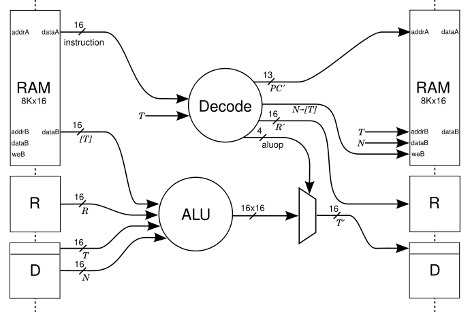[James Bowman] of the Willow Garage published a paper on his J1 CPU core for field-programmable gate arrays. This was originally developed and used for the Ethernet cameras on the PR2 (you know, that incredibly expensive beer delivery system?) robot. It uses a 16-bit von Neumann architecture and lacks several processor features you’d expect a CPU to have such as interrupts, multiply and divide, a condition register, and a carry flag. None-the-less, its compact at just 200 lines of Verilog and it can run at 80 MHz. [James] compares the J1 to three different FPGA CPU Cores commonly used and discusses how the system is built in his 4-page paper that has the details you’re interested in but won’t take all day to dig through.
fpga551 Articles
V4Z80P: The 8-bit Laptop

[Phil] over at Retroleum has cobbled together a clean, well put together laptop based entirely around a Zilog Z80 microprocessor and a pair of Spartan II FPGAs. These FPGAs allow him to reduce the number of devices on his board, and therefore cut his production cost as well as device size. He even managed to integrate a salvaged PSOne screen. The laptop comes complete with [Phil]’s own Homebrew OS as well as a great graphical vector based demo.
Sure he’s updated the project in recent years to shrink the board, speeding up the Z80, and increasing the peripheral speed and functionality, but we’re suckers here for a total package hack. Seriously though, check out the newest version of the device as well as the backlog that shows the project growing over time.
Thanks to [Steth] for the heads up.
Tiny Cray-1 Courtesy Of An FPGA
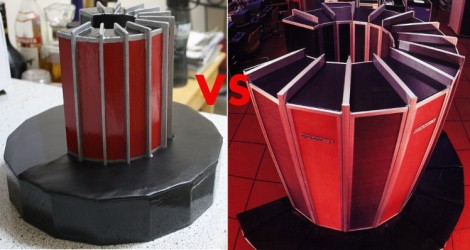
[Chris Fenton] spent a year and a half constructing a 1/10th scale Cray-1 reproduction. The famous supercomputer was meticulously modelled in a field programmable gate array for a “nearly cycle-accurate” reproduction. [Chris’] hardware of choice for the project is a Xilinx Spartan-3E 1600 development board, using 75-80% of the available resources. The finished product runs at 33 MHz and is missing a few functions but it sounds like they don’t affect code execution. We like that he didn’t stop with the processor implementation, but also took the time to produce a case for the development board that looks just like the original.
Unlike the Atari 2600 FPGA project, we’re not quite sure what we’d use this for. But that doesn’t diminish the excellence of his work.
Atari 2600 Recreated In An FPGA
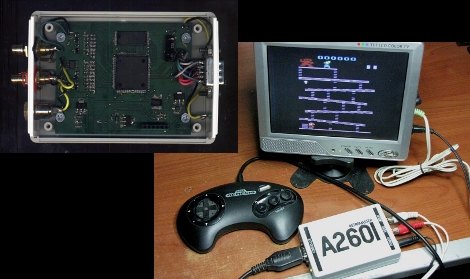
Behold [Retromaster’s] field programmable gate array implementation of an Atari 2600. The processor and video chip have both been built in the 100,000 gate Spartan-3E FPGA, with connectors for audio, video, and a Sega controller. The output signals are generated using two DACs made from R-2R resistor ladders, much like the project we saw in August. [Retromaster] included functionality for the system switches (difficulty and select) in the controller itself. There is VHDL code and board details available if you want to make one of your own. To help in making that decision we’ve embedded video of it after the break. Continue reading “Atari 2600 Recreated In An FPGA”
PET-Gaming Computer Module
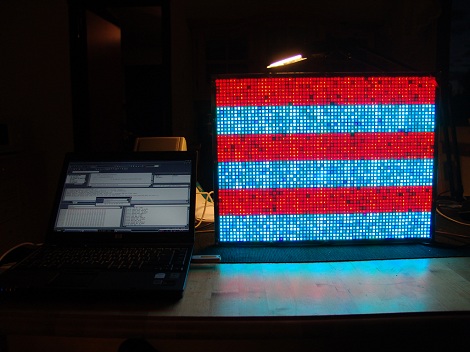
This 64×48 full color LED display goes much further than we expected at first glance. The display is actually a computer with a Zilog eZ80F91 core utilizing an FPGA for the hardware interface. Some nifty applications currently built include mostly games, but there is also visualizations, network file systems, video streaming, and even a MIDI synth.
It originally looked to be more of a console, with controllers, game pads, and cartridges, but the latter ended up not working out. What else would you do with a giant LED display?
SEGA Genesis Cloned With An FPGA
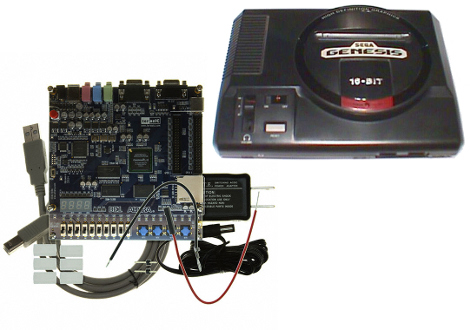
[Greg] managed to clone a SEGA Genesis using a field programmable gate array. He used a Terasic/Altera DE1 board, which will set you back about $160, during development. The onboard push buttons are currently used as the controller with VGA for the display. Who knows, maybe there’s enough programming space left to drive a PSP screen and turn this into a handheld?
You can see some gameplay footage after the break. If SEGA was never your thing don’t forget that there is an NES FPGA hack out there too.
Arduino Implemented On An FPGA
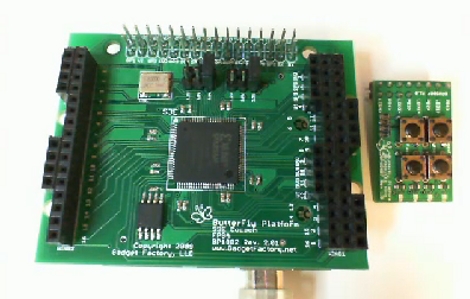
If you think that Arduinos are overkill in most projects we can do one better for you. [Jack Gassett] has a virtual Arduino running on a Field Programmable Gate Array. We checked in with [Jack] back in November to see his work with the AVR8 Soft Processor, an FPGA version of an AVR chip. Because the Arduino uses AVR it wasn’t too much of a leap to make this Arduino compatible. We’re lacking in imagination when hit comes to using this method productively, but we’re sure someone will find a way.
[Thanks Drone]

